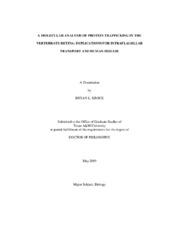| dc.description.abstract | Vertebrate photoreceptors are highly specialized sensory neurons that utilize a
modified cilium known as the outer segment to detect light. Proper trafficking of
proteins to the outer segment is essential for photoreceptor function and survival and
defects in this process lead to retinal disease. In this dissertation I focus on two aspects
of protein trafficking, intracellular vesicular trafficking in photoreceptors and retinal
pigmented epithelial (RPE) cells and how it relates to the human disease choroideremia
(CHM), and the trafficking of proteins through the photoreceptor cilium. The human
retinal degenerative disease choroideremia (CHM) is caused by mutation of the Rab
escort protein-1 (REP1) gene, which is required for proper intracellular vesicular
trafficking. However, it was unclear whether photoreceptor degeneration in this disease
is cell-autonomous, due to defective opsin transport within the photoreceptor, or is
noncell-autonomous and a secondary consequence of defective RPE. Utilizing the
technique of blastomere transplantation and a zebrafish line with a mutation in the rep1 gene, I show that photoreceptor degeneration in CHM is noncell-autonomous and is
caused by defective RPE.
The molecular machinery responsible for protein trafficking through the
photoreceptor cilium remained unclear for a long time. Recent studies found
Intraflagellar Transport (IFT) is the process that mediates cilia formation and transport
of proteins through a cilium, and further analyses showed IFT is important for
trafficking proteins to the outer segment. However, many details about how IFT works
in photoreceptors remained unclear. By analyzing zebrafish harboring a null mutation in
the ift57 gene, I show that Ift57 is only required for efficient IFT, and that the Ift57
protein plays a role in the ATP-dependent dissociation of kinesin II from the IFT
particle. Lastly, I investigate the role of retrograde IFT in photoreceptors, a process that
had yet to be investigated. By utilizing antisense morpholino oligonucleotides to inhibit
expression of cytoplasmic dynein-2 (the molecular motor that mediates retrograde IFT) ,
I show that retrograde IFT is required for outer segment extension and the recycling of
IFT proteins. | en |


